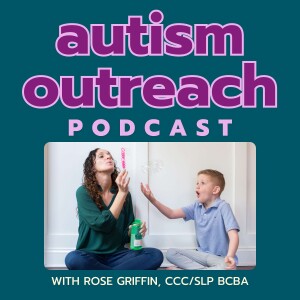
Autism Outreach - Easy Strategies For Parents and Professionals
Kids & Family:Parenting

#036: Supporting Parents and Early Intervention with Jaclynn Bosley
 2021-08-31
2021-08-31
Jaclynn Bosley is a great friend and colleague who I have worked with across many different settings over the years. She is the owner and operator of Thrive Early Learning Center. We discuss the importance of family involvement, some ideas for parents as they’re seeking the support of ABA therapy, and what early intervention looks like in Jaclynn’s center.
Getting a new diagnosis can be overwhelming for parents. Jaclyn reminds parents to take a deep breath and go to the expert and have them provide you with the road map of where to go next. Also, steer clear of Facebook groups and internet forums, it can often be a scary place if you don’t have the right questions or all the information. Trust your gut with your providers and do your research on the program that's right for your family.
We discuss some things to look for and think about when looking for and starting therapy.
Indicators of a good program:
- Transparency.
- Parental involvement.
- Children’s positive nonverbal cues.
- Human connection and relationship with the provider.
Funding sources for therapy:
- State-specific scholarship programs for children with Autism or other disabilities.
- Health Insurance. This is typically only for early intervention and can come with stipulations of reduced hours or a cap on hours as your child gets older.
- Beginning at 3, what services are your public schools required to offer?
For the Thrive Early Learning Center, Jacylnn starts with the initial intake. This will be in a scheduled block of time when no other students are in the building so that the child can have a full roam of the space. Parents and the clinical director will be present to observe and take down lots of anecdotal information. Assessments will take place once a child starts. At Thrive, they use ABLES or VB-MAPP. ABLES is great for students with more communication needs. VB-MAPP works for students with more language skills.
For group therapy at Thrive, it is typically a small group of 3-5 kids. One person is giving instruction as the students are participating, other therapists will come over and quietly prompt and redirect individuals if they get off task. One-on-one support can be a barrier layer because the therapist becomes the interpreter. Teaching students to cue into their environment by looking around to see what their peers are doing. Fading out prompts. They practice watching and listening to a leader during circle or story time. Then allow for shared activity during literacy centers, craft time, and gross motor play.
Jaclynn’s advice is that navigating therapy is a marathon, not a sprint, you don't have to be perfect coming out of the gate. Give yourself the grace to change and adapt. There is always time to make progress. When you first get a diagnosis, put yourself on narration mode, to keep your child immersed in the language, talk to your kids like you would even if they don't have a disability, and watch the journey unfold! You’ll get there together with your providers, and it will keep that journey happy!
What’s Inside:
- Parent involvement in therapy.
- Indicators of a good provider.
- What therapy looks like at Thrive Early Learning Center.
- Jaclynn’s advice for parents with a new diagnosis.
More Episodes
 2024-08-06
2024-08-06
 2024-07-16
2024-07-16
 2024-07-02
2024-07-02
Create your
podcast in
minutes
- Full-featured podcast site
- Unlimited storage and bandwidth
- Comprehensive podcast stats
- Distribute to Apple Podcasts, Spotify, and more
- Make money with your podcast
It is Free
- Privacy Policy
- Cookie Policy
- Terms of Use
- Consent Preferences
- Copyright © 2015-2024 Podbean.com




